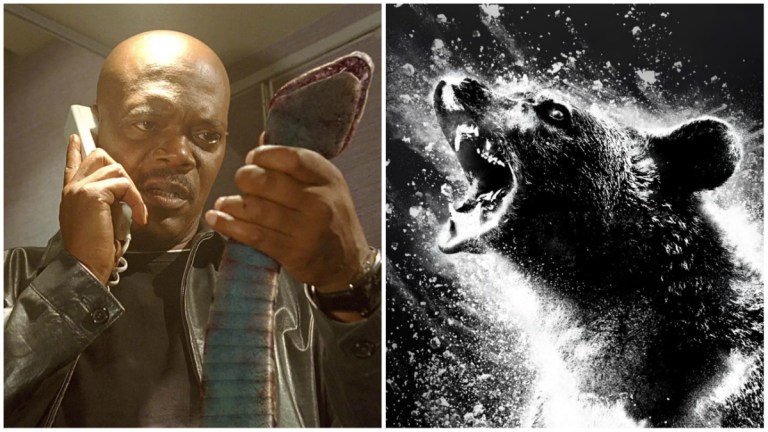Snakes on a Plane, Cocaine Bear, and Embracing Schlock Horror
Cocaine Bear springs out of a long and glorious history of schlock, from Snakes on a Plane to the origins of one of Elizabeth Banks' mentors...

Do you remember where you were when you heard about Cocaine Bear coming to theaters? How about Snakes on a Plane? Odds are you were on some corner of the internet, faffing around on social media, when a vibration ran through the service like a schoolyard rumor. It’s a different sensation than a blockbuster announcement meant to excite, isn’t it? It’s closer to awe, coupled with a can-you-believe-it hilarity. You look into it. It’s a movie with a goofy title, one of the dumbest premises you’ve ever heard, and a corny trailer that hits your funny bone like a brick. You gotta see this thing, just to say you’ve seen this thing. Welcome to the way of the schlock. Buy the salted caramel popcorn at the concession counter. It’s a special occasion.
To call a film “schlock” is affectionately rude. It’s garbage, sure, descended straight from the Yiddish word for mess. But a schlock film is usually like that on purpose and uses its exploitative thrills to endear itself to the audience. It’s a genre all its own, with an emphasis on horror and sci-fi. It’s stuff that can transcend its trash panda origins and become a beloved part of film history. To acknowledge a film’s schlockiness is basic critical analysis. But to dismiss schlock cinema is to live a life empty of killer tomatoes, killer clowns from outer space, killer amazon women on the Moon, and about 70 percent of Vincent Price’s filmography. That’s before we get to animals up to the wildest stuff you’ve never imagined.
A Not Very Evil But Very Dead Cocaine Bear
It’s Sam Raimi who’s stealing headlines as Banks’ directorial influence coming into Cocaine Bear. Not only is the Evil Dead trilogy a favorite of Banks, but it was Banks’ time as J. Jonah Jameson’s secretary, Betty Brant, in Raimi’s original Spider-Man trilogy that got her thinking about directing her own movies. Being by the side of a director who turned cheap schlock into an iconic horror franchise no doubt left an imprint on Banks’ own directorial style.
It’s never difficult to recognize that signature Raimi cinematography, honed by years of creativity on a low budget and a set of camera techniques that pull an audience into the heart of ongoing horror. Watching the best of his films, from the ultimate arthouse shlockfest Evil Dead to Darkman, a shlock superhero joyride that still deserves a sequel, is a crash course on recognizing the genre.
To sum up the former: the original Evil Dead (1981) is on a visibly thin budget, but its demonic fountain of gore doesn’t look cheap. It’s camp, because the acting is delightfully, purposefully over the top. It’s exploitative, because someone else dies or gets raped, or something even worse long before you can ever get bored. And the one-line plot goes from mundane to wild within the space of a couple words: A group of friends go on a vacation in a cabin in the woods, then accidentally unleash demons.
Evil Dead is the art of schlock in a can, and if you can only pick a single movie to try and understand the appeal of the cheapo exploitation horror movie, it’s this one. But Sam Raimi is just an origin story. To get to why a bear hopped up on cocaine has us all in a death grip, we have to switch transportation from Evil Dead and Sam Raimi’s “classic” car to a plane.
Taking a Snake-Laden Jet to Cocaine Bear Island
2006 was the year schlock made it big. The setup began in late 2005 when screenwriter Josh Friedman used his blog to tell the story of how he nearly became the script doctor for a film called Snakes on a Plane. It’s best to read it for yourself, as Friedman’s storytelling proves why he’s successful in his industry. But the upshot is he didn’t stay on the job because the studio, in their blindness, was on the verge of changing the title to something safe. Like Flight 21. Or Plane. Who would name a movie Plane?
Anyway, the blog post went viral. The studio, helped along by Samuel L. Jackson’s wise but profane insistence, asserted the film would, in fact, be titled Snakes on a Plane. And around August 2006, these airborne snakes were unleashed upon a vaguely suspecting internet. This was the era where YTMND clips were our TikTok, and FARK.com was our Reddit, and we already knew Sam Jackson had turned cussing into an art form. We were ready for some big screen schlock.
The original trailer is art, in a terrible, mid-‘90s sort of way that was already dated upon release. The Batman Forever-style horror font frames sequences of snakes—yes, on a plane—just barely missing their unsuspecting prey back in Economy Class. Lovers in a clinch are at risk from snakes prepping a dive bomb maneuver. Jackson is FBI agent Neville Flynn, in the midst of, as he says, a security scenario his team had never prepared for. All that’s missing is the one-liner heard around the world: “I’ve had it with these motherfucking snakes on this motherfucking plane!”
It’s a phrase that made it in during reshoots several months before release, during the interregnum between Friedman’s blog and the first trailer reveal, and it exists partially because of the growing frenzy for a film that was becoming more of an experience than a mere piece of cinema. Now R-rated, with Jackson’s mouth fully unleashed and the gore amplified, Snakes on a Plane became, well, a moderate hit. That made its profit on DVD and home media. So not quite a modern Rocky Horror Picture Show once the phenomena left the internet. Some theaters, nonetheless, saw fans in SoaP gear, tossing rubber snakes at each other during the screening.
It’s that energy that’s helped the SyFy channel bring to life a new era of terrible but fun movies, from Corman-style ripoffs to Sharknado. Their success in being boldly stupid has also created a new era of big screen movies that feel straight-to-video, like Gerard Butler’s silly but successful action movie career, and Jason Statham’s megalodon-sized box office success.
And yet, while our fond memories of the Snakes on a Plane frenzy is the obvious lesson to look at when assessing the ongoing viral impact of Cocaine Bear, it’s not the whole story, either. For that, we turn briefly to earlier in 2006 and James Gunn.
Slithering Toward Cocaine Bear
Today, James Gunn is in charge of restructuring the DC superhero universe for Warner Bros. It’s been a long journey for Gunn, but his pulpy style is still visible in his project slate. Gunn grew up on schlock horror and Romero zombies, and in the mid ‘90s, he landed a dream job screenwriting for indie schlock distributor Troma, arguably best known for the Toxic Avenger saga. Troma’s entire shtick is shock and awe, and their famous crassness is what pays the bills.
2006’s Slither was Gunn’s directorial debut, and with him were a number of faces familiar to Gunn fans like Michael Rooker. But it’s Elizabeth Banks that gets to be the film’s sturdy center. No damsel in distress, Banks, as Starla Grant, gets to go hands-on with some high-test blood squibs, oopy goopy blood slime, and Michael Rooker, as her spouse, after he’s turned into a violent space worm… thing. That’s the sort of gig that leaves its mark, and Banks has mentioned that Slither is among the films that inspired a film that’s ready to get as subversive and dark as it needs to make us laugh in horror.
All Hail the Cocaine Bear
From these beginnings, Banks shows she’s been ready to be part of something schlockingly special all along. Her first two directorial projects were safe, with the first being quite successful. Banks put her own spin on the AcaBellas in Pitch Perfect 2, which earned her a box office win, and then Charlie’s Angels in the 2019 revival, which you may have forgotten about. The critical and box office receipts show why.
But rather than dwell on the past, the future of the Cocaine Bear was still visible in Banks’ jaunty visual style and brazen sense of humor. Where her previous efforts didn’t land, they inform the mad genius of the trailers that caught today’s internet denizens in a bear trap of amazement. From using the lessons of Snakes on a Plane to build a viral advertising campaign with today’s internet tools to learning from the experiences of two directors that helped schlock go mainstream, Banks, with the help of a slightly true story about a bear ripped to the claws on cocaine, is ready to bring a new golden era of high-quality schlock to movie theaters worldwide.
Despite Banks’ fears of Cocaine Bear being a career ender for her, in our opinion, there’s no way to lose. If Cocaine Bear is a box office hit, she’ll have her pick of top shelf gonzo films. If it peters off when it hits theaters, as Snakes on a Plane did, the world of cheap horror will still welcome its new queen.
